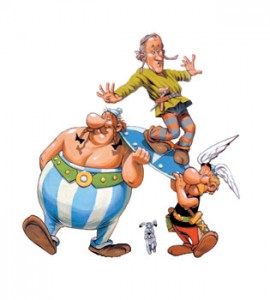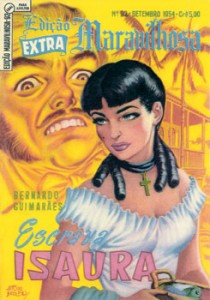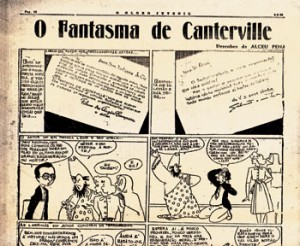 ReproductionIn 1944, the Revista do Inep magazine, published by the Ministry of Culture’s Instituto Nacional de Estudos Pedagógicos, Institute of Pedagogical Studies, published an earth-shaking study in three issues. The study was based on a survey with teachers and students on comic books, a mass product that had been introduced to Brazil in the previous decade. The conclusion of the study was alarming: comic books were a harmful instrument that was jeopardizing academic education in various ways: discouraging the study of the disciplines, abandonment of children’s books and, worse of all, comic books led to mental laziness because they addicted the students to images and skimpy texts. In the aftermath of the study, a battle took place in schools around the country, when fires were organized to burn the comic books. More fat was thrown into the fire when in 1958 professor Antonio D’Ávila published A literatura infanto-juvenil, a treatise that defended children’s books and attacked comic books.
ReproductionIn 1944, the Revista do Inep magazine, published by the Ministry of Culture’s Instituto Nacional de Estudos Pedagógicos, Institute of Pedagogical Studies, published an earth-shaking study in three issues. The study was based on a survey with teachers and students on comic books, a mass product that had been introduced to Brazil in the previous decade. The conclusion of the study was alarming: comic books were a harmful instrument that was jeopardizing academic education in various ways: discouraging the study of the disciplines, abandonment of children’s books and, worse of all, comic books led to mental laziness because they addicted the students to images and skimpy texts. In the aftermath of the study, a battle took place in schools around the country, when fires were organized to burn the comic books. More fat was thrown into the fire when in 1958 professor Antonio D’Ávila published A literatura infanto-juvenil, a treatise that defended children’s books and attacked comic books.
It took two decades for publishers such as Ibep and Ática to adopt comic book language in their Portuguese, geography, history and math books. Ever since, it has seemed that teachers have peacefully accepted the use of comic books as a para-didactic reinforcement tool. In fact, comic books have almost always been the first contact in various generations of children with reading, writing and entertainment; in addition, they have often been the object of great affection, always linked to childhood. This is the argument exposed in the thesis written by Valéria Aparecida Bari: O potencial das histórias em quadrinhos na formação de leitores: busca de um contraponto entre os panoramas culturais brasileiro e europeu, under the guidance of professor Waldomiro de Castro Santos Vergueiro, from USP’s School of Arts and Communications/ECA.
In her research, she discusses the importance of comic books in shaping children’s taste for books, based on experiences in two countries: Brazil and Spain. At the same time, she focuses on the understanding of the messages transmitted by the text in the stories and by the drawings – which cannot be dissociated one from the other and are complementary to one another in this kind of art. According to the researcher, the elements that comprise comic books, such as literacy, open up possibilities for the insertion of sequential graphic language products in current library and pedagogical practices. “The reading of comic book stories shapes readers that like all kinds of literature, with the advantage that this also creates a childhood reading culture and broad reading communities”, she points out. “After all, it must be kept in mind that the training of a reader only achieves maturity if the person enjoys reading. The emotional link is a fundamental element. In this sense, comic book stories, in addition to showing complex contents in an easy manner to beginner readers, also bring to maturity the emotional relationship between the reader and what he is reading”.
The researcher points out that in a country which only a short time ago was predominantly illiterate, the first contact of the majority of the population with reading occurred in classrooms and public libraries. “We have a generation which, at the beginning of the 21st century, was encouraged to enter a literate and virtualized world, where the reading experience had no meaning in real life. Only pleasure and taste can justify this effort to go up the huge steps comprising literacy and literateness”. In her opinion, the hybrid language of comic books, which combines text and image to form complex meanings, results in an attentive, eclectic and proficient reader, able to read several medias and languages competently, and able to produce quality organization of ideas and the formulation of written texts, with entertainment and articulation.
 ReproductionLiteracy, she goes on, encompasses evolutionary phases as the pre-requisites for the acquisition of reading skills and competencies. First is the decoding phase, which requires memorizing the register of the written language and its graphic reproduction. Second is the reproduction, repetition and own production phase, which requires the memorizing of written language’s more complex structures, while at the same time requires the development of motor skills to reproduce the letters and graphic signs, linguistic competencies and linking of ideas and reasoning. “Reading and writing as exercises of reproduction, repetition, and production – when well conducted – lead to the acquisition of reading habits. Habits, in turn, lead to the love of reading, the most sophisticated and personal part of the process to make someone literate”.
ReproductionLiteracy, she goes on, encompasses evolutionary phases as the pre-requisites for the acquisition of reading skills and competencies. First is the decoding phase, which requires memorizing the register of the written language and its graphic reproduction. Second is the reproduction, repetition and own production phase, which requires the memorizing of written language’s more complex structures, while at the same time requires the development of motor skills to reproduce the letters and graphic signs, linguistic competencies and linking of ideas and reasoning. “Reading and writing as exercises of reproduction, repetition, and production – when well conducted – lead to the acquisition of reading habits. Habits, in turn, lead to the love of reading, the most sophisticated and personal part of the process to make someone literate”.
In this context, comic book stories are an important contribution to all these phases: they help memorizing, naturally stimulate the reader’s reproduction and own production, lead children to acquire reading habits and, very clearly, shape the reader’s taste. “All of these phases have one common element, which comprises the huge mental effort, suffering and necessary commitment, by the individual, to achieve successful literacy. The additional advantage is that these three elements prepare the brain to exercise the left and right amygdalae, because they use hybrid language, facilitating subjectivity and preparing the brain for complex thoughts”. In her opinion, it would be impossible to understand the reader training phenomenon, that is, the literacy phenomenon, without the social experiences in the environments in which the social appropriation of reading occurs. Nor would it be possible to become a specialist without living and re-living the phenomenon of reading in its full state. “Comic books draw attention to the more positive aspects of reading, making the teaching of reading more effective and aimed at shaping the reader’s reading tastes and personality, as I observed during the interviews form my research study, going beyond the reading necessary to support scientific research”.
 ReproductionValeria’s research work seems to have put a stop to Brazil’s decades-long prejudice towards comic books. “The undeniable popularity of comic books was perhaps responsible for a kind of mistrust of the effects they could have on readers. In view of the fact that they are a widely consumed means of communication and that their contents are focused on young people, comic books had become, early on, object of restrictions imposed by parents and teachers”, points out Waldomiro Vergueiro, coordinator of the Núcleo de Pesquisas em Histórias em Quadrinhos, Center for Research on Comic Books at ECA-USP and organizer of the book Como usar as histórias em quadrinhos na sala de aula (Editora Contexto, 160 pages, R$ 25,00), together with Angela Rama, Alexandre Barbosa, Paulo Ramos and Túlio Vilela. The prejudice towards comic books weakened only after comic books had gained a new status, especially in Europe, as an art form and comic books began to be quietly included in educational material. At first, they were used to illustrate parts of school subjects that had previously been explained through written texts. “Mistakes and exaggerations occurred at first, due to the lack of experience in using comic books in the school environment, but initiatives were conducted to refine this process”, says Vergueiro. Nowadays, it is common to resort to comic books to transmit content, especially after the evaluation conducted by the Ministry of Culture in the mid-1990s. More recently, the use of comic books in education has been recognized by the Lei de Diretrizes e Bases/LDB law and by the Parâmetros Curriculares Nacionais/PCN Guidelines for Education. “For several decades, comic books have been part of the daily lives of young people and therefore the inclusion of this material in the classroom is not the object of rejection by students who generally view this inclusion enthusiastically”.
ReproductionValeria’s research work seems to have put a stop to Brazil’s decades-long prejudice towards comic books. “The undeniable popularity of comic books was perhaps responsible for a kind of mistrust of the effects they could have on readers. In view of the fact that they are a widely consumed means of communication and that their contents are focused on young people, comic books had become, early on, object of restrictions imposed by parents and teachers”, points out Waldomiro Vergueiro, coordinator of the Núcleo de Pesquisas em Histórias em Quadrinhos, Center for Research on Comic Books at ECA-USP and organizer of the book Como usar as histórias em quadrinhos na sala de aula (Editora Contexto, 160 pages, R$ 25,00), together with Angela Rama, Alexandre Barbosa, Paulo Ramos and Túlio Vilela. The prejudice towards comic books weakened only after comic books had gained a new status, especially in Europe, as an art form and comic books began to be quietly included in educational material. At first, they were used to illustrate parts of school subjects that had previously been explained through written texts. “Mistakes and exaggerations occurred at first, due to the lack of experience in using comic books in the school environment, but initiatives were conducted to refine this process”, says Vergueiro. Nowadays, it is common to resort to comic books to transmit content, especially after the evaluation conducted by the Ministry of Culture in the mid-1990s. More recently, the use of comic books in education has been recognized by the Lei de Diretrizes e Bases/LDB law and by the Parâmetros Curriculares Nacionais/PCN Guidelines for Education. “For several decades, comic books have been part of the daily lives of young people and therefore the inclusion of this material in the classroom is not the object of rejection by students who generally view this inclusion enthusiastically”.
Vergueiro laments the fact that comic books are not being used extensively in classrooms not only in Brazil but also around the world. The fact is that they could be used in several different ways – as para-didactic reinforcement, stimulus for literacy (as comic books are a form of entertainment), etc. “The interconnection of the text and the image in comic books broadens the comprehension of a form that either of the two codes would be unable to achieve alone”. According to the professor, some of the teachers are still not familiar with this genre, which prevents them from knowing what to choose and how to use their choice in the classroom. “This unfamiliarity, in addition to the skimpy government incentive that exists at the moment in the sense of fostering the use of comic books, leads to the initiative being left mostly to the teachers”.
As an argument to encourage the use of comic books in the classroom, he emphasizes the students’ familiarity with comic books and with the language elements. This familiarity, which begins in the early stages of childhood, is coupled with easy access to the product (sold at newspaper stands), the low-cost of the material in comparison to other means of communication, the possibility of applying comic books to all fields and disciplines, and the possibility of developing multi-disciplinary studies and projects with comic books. “I think our attitude should be one of permanently explaining to teachers the advantages and possibilities of using comic books in the classroom”.
 ReproductionIn Vergueiro’s opinion, the first step in this respect would be to train future teachers who, during their undergraduate studies, could and should have contact with comic books as a work instrument in their future profession. To this end, they should become familiar with leading productions in this field and be advised on how to use them as tools in the classroom environment. “The preconceived idea that comic books draw children and young people away from reading books and other materials has already been refuted by a number of studies. Today we know that comic book readers also read other kinds of newspapers, magazines, etc. The broadening of the familiarity of reading comic books in the classroom leads many students to open up to reading and find it less difficult to concentrate on reading the necessary material for learning purposes”. Some people argue that comic books are an excellent way of facilitating the access to reading. “It is already generally acknowledged that comic books are a pedagogical resource. However, in schools in general – schools are the institutions that ratify the use of comic books as being an instrument for teaching and learning – the prevailing idea is that comic books are merely a learning aid, and not a dialogue with literacy. There is a lack of awareness in relation to comic books and the communication possibilities they offer”, explains Maria Cristina Xavier de Oliveira, whose doctorate thesis A arte dos quadrinhos e o literário, was presented at USP a few months. Her advisor was Nelly Novaes Coelho.
ReproductionIn Vergueiro’s opinion, the first step in this respect would be to train future teachers who, during their undergraduate studies, could and should have contact with comic books as a work instrument in their future profession. To this end, they should become familiar with leading productions in this field and be advised on how to use them as tools in the classroom environment. “The preconceived idea that comic books draw children and young people away from reading books and other materials has already been refuted by a number of studies. Today we know that comic book readers also read other kinds of newspapers, magazines, etc. The broadening of the familiarity of reading comic books in the classroom leads many students to open up to reading and find it less difficult to concentrate on reading the necessary material for learning purposes”. Some people argue that comic books are an excellent way of facilitating the access to reading. “It is already generally acknowledged that comic books are a pedagogical resource. However, in schools in general – schools are the institutions that ratify the use of comic books as being an instrument for teaching and learning – the prevailing idea is that comic books are merely a learning aid, and not a dialogue with literacy. There is a lack of awareness in relation to comic books and the communication possibilities they offer”, explains Maria Cristina Xavier de Oliveira, whose doctorate thesis A arte dos quadrinhos e o literário, was presented at USP a few months. Her advisor was Nelly Novaes Coelho.
Comic books provide a new way of creating texts and of reading. It is an art that, unlike common belief, has to be learned and understood. The comic book is a means that can serve many purposes, such as arousing a creative outlook, allowing quick reasoning, linking ideas, dominating techniques of composition and visual exploration. Comic books can be a means to train readers “not passive, merely receptive readers, but active, collaborative readers who are important for the reading and construction of new texts”, she says. Who said that the comic book you love to read is ‘just a comic book’? This person was certainly someone who did not participate in the Campanha de Desarmamento Infantil, the Child Disarmament Campaign held in the city of Recife. In just a few weeks, more than 500 thousand toy weapons were traded in for comic books. The pen that illustrates comic book drawings is certainly much more powerful than the sword or the gun, and a comic book is much more pleasant to see.
Republish